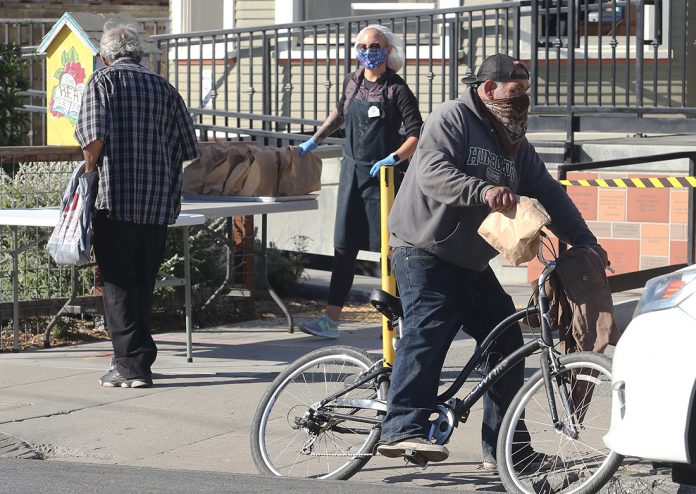WATSONVILLE—One year ago, a report by UC Santa Cruz’s Blum Center on Poverty, Social Enterprise and Participatory Governance and Second Harvest Food Bank painted a grim picture of hunger in Santa Cruz County.
According to the report, some 83,000 residents were living in households earning less than $50,000 per year. Among these, 43% of food assistance needs went unmet in 2017-18, forcing families to seek out cheaper, less nutritious options.
This raises concerns among social services agencies of ‘food insecurity,’ when people lack the means and resources to get nutritious food. The problem typically manifests itself in high rates of obesity and diabetes, both problems that plague South County.
Monterey County, says Monterey County Food Bank Executive Director Melissa Kendrick, has the highest levels of type-2 diabetes in the state.
“We have to get ahead of that, and the only way we can do that is through healthy eating,” she said.
And this was before the Covid-19 pandemic sent a depth-charge into the economy and forced hundreds more to seek out food assistance after losing their jobs.
According to Second Harvest Food Bank Development and Marketing Officer Suzanne Willis, the food bank before the pandemic served about 55,000 people monthly, providing parcels of fresh produce and pantry staples. Now, that number has climbed to approximately 88,000.
The problem is typically compounded every year when tourism and agricultural work dry up and more families need help feeding themselves, and making a living in Santa Cruz County.
“If you’re spending everything you have on rent and medical and gas, you don’t have the funds for food,” Willis said.
“A lot of the work we’re trying to do is make sure people have access to the fresh produce, the lean proteins and the whole grains they need, but also the knowledge on how to use it,” Willis said.
Willis says the problem is a complex one, and is mixed in with social, racial and economic injustice, economic insecurity, food insecurity, housing insecurity and high poverty rate.
“All of it ties in together and it all has this snowball effect on a person who maybe is kind of making it, and all of a sudden you throw in a broken car or a cancer diagnosis or something, that is the kind of thing that will throw a family on the edge completely over it,” Willis said
Willis pointed out that, during the economic recession, the Food Bank’s numbers went from 30,000 to 50,000 visits per month, and never went down. She predicts the same pattern will emerge in the wake of the pandemic.
“I really don’t anticipate those numbers ever going down significantly from where they are now,” she said. “I suspect Covid is going to be the same kind of multiplier.”
At Loaves and Fishes in Watsonville, volunteers saw an initial 20% increase in the number of people coming to the organization’s weekday lunch program—equating to about 150 people per day—immediately after the Covid-19 crisis began, said Director Ashley Bridges.
That number has since stabilized to around 60 people per day, she said.
But the number of families that receive food from its Pantry Program has nearly doubled, with 1,500 people per month receiving food assistance, many needing help twice a month, Bridges said.
“The pandemic definitely hit our community really hard,” she said.
One bright side, she says, is that the pandemic has allowed Loaves and Fishes to connect with local organizations that are helping out, such as the Community Action Board of Santa Cruz County, and Live Earth Farm, which provides produce.
“I personally have been really grateful for how the community has come together to help the people we serve,” she said.
The problem is worse in Monterey County, where 1 in 3 children go hungry and more than 33% of students are homeless, said Kendrick.
“Our numbers have quadrupled,” she said. “We’re just bracing for tremendous hardship.”
Part of the challenge, she says, is the sheer size of the county, which encompasses more than 3,770 square miles and—with tourist destinations such as Fisherman’s Wharf and vast agricultural areas—includes a wide range of economic strata.
“Our territory is enormous, with vastly different needs,” she said.
When the pandemic hit, Kendrick says, many of the county’s 160 nonprofit organizations were forced to close. Of those, only 60 remain open, many with limited services.
As a result, the Monterey County Food Bank offers 50 food distributions per week, each of which see from 200-800 families, Kendrick said.
This has proven logistically challenging because of social distancing restrictions which among other things require volunteers to place food directly into recipients’ trunks.
“We have had to completely reimagine how we do things,” she said.
All of this makes food banks’ missions difficult, Kendrick said.
Still, it happens thanks to “phenomenal” staff and to the ongoing donations that are the lifeblood of food banks, she said.













